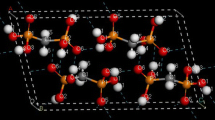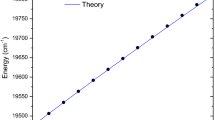Abstract
On the basis of pseudopotential theory, within the framework of a formally accurate model perturbation theory of Rayleigh—Schrödinger type with a zero-approximation inoculating potential, the calculation of some diatomic alkali molecules in homo- and heteronuclear variants LiM (M = Li, Na, K, Rb, Cs, Fr) is considered. A local model potential of Gell-Mann type is adopted as the zero-approximation potential. The calculation results for the energy parameters — in particular, the energy of dissociation — are given; some of these results are obtained here for the first time. The calculation demonstrates the fundamental role of two basic second-order perturbation-theory effects in achieving acceptable accuracy: polarizational interaction of the valence particles through the core; and mutual screening of these particles.
Similar content being viewed by others
References
K.-P. Huber and G. Hertzberg, Constants of Diatomic Molecules [Russian translation], Vols. 1 and 2, Mir, Moscow (1984).
E. E. Nikitin and S. Ya. Umanskii, Achievements in Science and Engineering: Molecular Structure and Chemical Bonds [in Russian], No. 4, VINITI, Moscow (1980).
H. Haberland, Y. T. Lee, and P. E. Siska, "Excited states in chemical physics," in: J. W. McGowan (ed.), Advances in Chemical Physics, Vol. 5, Chap. 6, Wiley, New York (1981), pp. 457–478.
P. Durand and J. P. Malriew, in:Ab Initio Methods of Quantum Chemistry, K. P. Lawley, Chichester, et al. (eds.), Wiley, New York (1987).
P. Gombas, Pseudopotentiale, Springer, Berlin (1967).
M. Frauss and W. Stevens, J. Chem. Phys.,93, No. 6, 4236–4242 (1990).
C. M. Rohlfing and P. J. Hay, J. Chem. Phys.,83, No. 9, 4641–4649 (1985).
L. Bellomonte, F. Cavaliere, and G. Ferrante, J. Chem. Phys.,61, No. 8, 3225–3234 (1974).
C. Bottcher and A. Dalgarno, Proc. Roy. Soc. (London) A,340, 187–196 (1974).
G. K. Ivanov, Teor. Éksp. Khim.,14, No. 1, 110–115 (1978).
A. V. Nemukhin and N. F. Stepanov, Vestn. MGU, Ser. 2, Khim.,18, No. 3, 282–286 (1977).
O. V. Gritsenko and G. M. Zhidomirov, Zh. Strukt. Khim.,28, No. 2, 140–178 (1987).
A. V. Glushkov, Zh. Strukt. Khim.,34, No. 5, 3–10 (1993).
A. V. Glushkov, Zh. Strukt. Khim.,36, No. 4, 608–614 (1995).
A. V. Glushkov, Zh. Strukt. Khim.,29, No. 4, 3–10 (1988);30, No. 6, 3–6 (1989);31, No. 1, 11–14 (1990);31, No. 4, 11–16 (1990).
A. V. Glushkov, N. N. Dudnik, and S. V. Malinovskaya, Zh. Strukt. Khim.,29, No. 1, 165–167 (1988).
A. V. Glushkov and S. V. Malinovskaya, Zh. Fiz. Khim.,62, No. 1, 100–105 (1988).
A. V. Glushkov, Zh. Fiz. Khim.,63, No. 11, 2895–2898 (1989);64, No. 11, 3100–3103 (1990);65, No. 11, 2970–2977 (1991).
A. V. Glushkov, Opt. Spektrosk.,77, No. 1, 5–10 (1994).
A. V. Glushkov, Izv. Vyssh. Uchebn. Zaved., Fiz.,33, No. 9, 41–46 (1990);35, No. 11, 3–9 (1992);37, No. 6, 31–38 (1994).
A. V. Glushkov, S. V. Ambrosov, T. V. Buyadzhi , et al., Zh. Prikl. Spektrosk.,64, No. 2, 260–263.
V. V. Tolmachev, Adv. Chem. Phys.,14, 421–482 (1969).
V. V. Tolmachev, L. N. Ivanov, and E. P. Ivanova, Izv. Vyssh. Uchebn. Zaved., Fiz., No. 12, 84–89 (1969).
A. V. Glushkov, L. N. Ivanov, and E. P. Ivanova, autoionization Phenomena in Atoms [in Russian], MGU, Moscow (1986), p. 58.
V. S. Letochov and L. N. Ivanov, Com. At. Mol. Phys. D, No. 4, 169–192 (1985).
E. P. Ianova, L. N. Ivanov, A. V. Glushkov, and A. E. Kramida, Phys. Scripta,32, No. 4, 512–524 (1985).
A. V. Glushkov and E. P. Ivanova, J. Quant. Spectr. Rad. Trans.,36, No. 2, 127–145 (1986).
A. V. Glushkov and L. N. Ivanov, Phys. Lett. A,170, No. 1, 33–36 (1992).
A. V. Glushkov, Pis’ma Zh. Éksp. Teor. Fiz.,55, No. 2, 104–107 (1992).
A. V. Glushkov and L. N. Ivanov, J. Phys. B,26, No. 16, L379–386 (1993).
M. D. Dolgushin, Zh. Fiz. Khim.,64, No. 12, 3250–3256 (1990).
A. V. Glushkov and Yu. A. Kruglyak, Opt. Spektrosk.,58, No. 5, 1159–1162 (1985).
A. V. Glushkov, Zh. Prikl. Spektrosk.,49, No. 4, 840–843 (1988).
J. Harris and R. O. Jones, J. Chem. Phys.,68, No. 4, 1190–1198 (1978).
K. Miller and A. E. S. Green, J. Chem. Phys.,60, No. 7, 2426–2432 (1974).
Additional information
Odessa Hydrometeorological Institute. Translated from Izvestiya Vysshikh Uchebnykh Zavedenii, Fizika, No. 5, pp. 106–113, May, 1998.
Rights and permissions
About this article
Cite this article
Glushkov, A.V., Efimov, V.A., Gopchenko, E.D. et al. Calculation of alkali-metal dimers on the basis of a model perturbation theory. Russ Phys J 41, 492–498 (1998). https://doi.org/10.1007/BF02766513
Received:
Issue Date:
DOI: https://doi.org/10.1007/BF02766513




